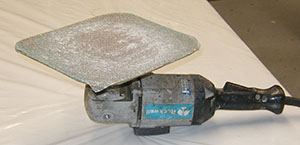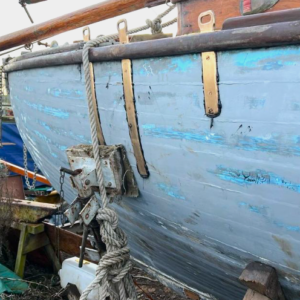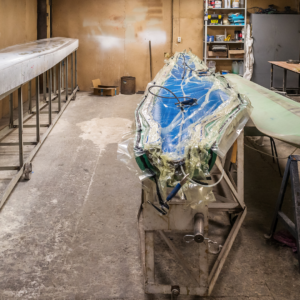How To: Our top 5 tips for fairing a hull
Fairing a hull may seem like an overwhelming task but there are ways that you can make the process a lot easier, whilst also achieving a great smooth finish. Before using fairing boards for final fairing, why not try working with a grinder? You will need to be careful handling the device in order to control the removal, however this method can remove a substantial amount of material very quickly.
Preparing your sander
Glue a 9″ × 11″ fibreglass piece onto the standard round foam backup pad on your 0 to 6,000 rpm sander/polisher to prevent gouging the surface. This soft foam is used on concave surfaces. If you’re not sure where to get a fibreglass ‘rectangle’, try an industrial supplier or make your own by laminating three layers of double bias 450g/m2 biaxial fibreglass sandwiched between single layers of 200g/m2 woven cloth and unthickened WEST SY STEM® epoxy.
STEM® epoxy.
For safety, it’s probably a good idea at this stage to cut the corners of the square pad to a radius of 50mm and sand all the edges. It should end up looking something like this:
Drawing ‘glue’ and ‘sight’ lines
Be careful to make sure you attach the foam exactly into the centre to avoid distortions. In order to do this, you can use a centre punch to mark the middle and then with a pencil compass or scriber, mark a circle the exact size of the pad’s diameter. This is the glue line. After this, make a concentric ring 3mm larger – this is the sight line. This is important because once the epoxy starts to squeeze out, the glue line may not easily be visible. Finally, ensure both surfaces have been abraded with sandpaper.
Applying epoxy to each surface
Next, apply two thin, level coats of unthickened WEST SYSTEM epoxy on each surface, making sure that the surface beneath the square is flat. Your clamping system should be simply four 25mm x 100mm boards about 300mm long and 2kg lead weights. This passive clamping protects the foam from permanent distortion.
Make sure never to store the pad on its face with the machine attached, as this will distort the foam making it unusable.
Top Tips
- When using a variable speed machine, we recommend you start with a slower speed until you are comfortable using it. We find the optimum speed to be around 3,000 rpm.
- Avoid moving in a fore and aft direction on a waterline– it is crucial to use a continuous diagonal movement across the surface.
- Move your feet 3″ to 4″ for every pair of arm passes. Ensure that this constant motion is used across all areas including hard to reach areas– this can be a bit of a pain but it’s very important.
- We found that the best approach is to do multiple passes, removing small amounts of material each time. You will notice as you go that visible irregularities will disappear. Dust off the hull several times throughout this stage so you can inspect the progress thoroughly.
- You can use a pencil to mark any imperfections and it would also be a good idea to mark the entire surface as you go along, to keep track of the areas you’ve completed.
There you have it, our sanding tricks of the trade. Try them out next time you need to complete a hull fairing job to make the task a little easier for you.
Our thanks to Damian McLaughlin for his great ideas.
Visit West System International for more tips on fairing and view the full range of WEST SYSTEM epoxy here.



